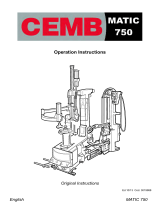
The authorised operators must perform on the
machine only the interventions of their specic
competence.
Before performing any intervention on the machine,
the authorised operators must make sure they are
in full possession of their physical and psychological
abilities in order to assure at any time the respect of
the safety conditions.
This technical manual is destined exclusively to authorised
operators charged with the use and maintenance of the
machine according to the specic technical and professional
competences required for the type of intervention involved. The
symbols here below are placed at the beginning of a paragraph
and indicate the operator involved in the handed topic.
CHARGED OPERATOR: This is an operator being
at least 18 years old (private user or worker), who, in
compliance with the provisions of the laws in force in
the country of use on safety and health in work places,
can perform exclusively the switching-on, use and
switching-off of the machine in full observance of the
instructors container in the manual, being equipped
with the personal protection equipment.
MECHANICAL / PNEUMATIC MAINTENANCE
ENGINEER: This is the trained technical engineer
qualied to perform exclusively interventions on the
mechanical / pneumatic parts in order to carry out
adjustment, maintenance and/or repair procedures
even with disabled protections in full observance of
the instructions contained in this manual or in any
other specic document exclusively supplied by the
manufacturer, being equipped with the personal
protection equipment.
ELECTRICAL MAINTENANCE ENGINEER: This
is a trained technical engineer qualied to perform
intervention exclusively on electrical devices in order
to carry out adjustment, maintenance and or repair
procedures also with live voltage and with disabled
protections in full observance of the instructions
contained in this manual or in another specic
documents exclusively supplied by the manufacturer,
being equipped with the personal protection equipment.
COMPANY SAFERY MANAGER: This is a qualied
technical engineer, appointed by the employer (in
case the machine is used in a company), meeting
the technical and professional requirements
foreseen by the regulators in force concerning the
safety and health of workers in the place of work.
MANUFACTURER’S TECHNICAL ENGINEER: This
is a qualied technical engineer supplied by the
manufacturer and/or authorized dealer to perform the
required technical assistance, as well as interventions
of routine and supplementary maintenance and/or
procedures not described in this manual requiring
a specic knowledge of the machine, being
equipped with the personal protection equipment.
This manual is integral part of the machine and must
be preserved for future reference until disposal of the
same. This manual must always be available for the charged
operators and has to be placed well stored and preserved near
to the machine.
Before using the machine, the authorized operators
Must read and understand this manual in all its parts.
This manual of “use and maintenance instructions” was drawn
up according to the provisions foreseen by the “Machinery
Directive” 2006/42/EC in order to assume an easy and correct
comprehension of the contents handled by the authorised
operators. Therefore, it must always be placed, well guarded
and preserved, near the the machine.
THE IMPORTANCE OF THE MANUAL
ADDRESSEES SAFETY WARNINGS
The manufacturer cannot be made liable for
damages to persons, animals and things, due to the
inobservance of the standards and of the instructions
described in this manual.
The manual has compulsorily to be delivered together
with the machine, in case this latter is transferred to
another user.
This manual meets the state of art when the machine
is traded and cannot be considered improper just
because following to new experiences it can then be
updated.
In case of loss or wear of the manual, equest a new
copy from the manufacturer or authorised dealer
specifying the model of the machine and the revision
quoted on the cover.
APPLIED SAFETY DEVICES
1.
SAFETY VALVE: this is a certied safety valve (calibrated
on 10,5 bar), installed on the pneumatic plant under the
pressure switch. It is used to discharge the overpressure
of the plant, when the pressure switch does not work due
to possible malfunctions. The tripping of the safety valve
obliges the operator to switch off the machine and require
the intervention of the maintenance technical engineers.
2.
PRESSURE SWITCH: this is an elector-pneumatic
device (calibrated on min. 7 bar and max. 10 bar)
installed on the pneumatic plant. It is used to command
the automatic start of the machine, when the operation
pressure falls under 7 bar, as well as the automatic
stop when the operation pressure reaches 10 bars.
3.
FIXED PROTECTION GRATING OF THE COOLING
FAN : This is afxed protection made up of a grating
in plastic material fastened by screws to the base of
the bi-cylindrical pumping assembly. It is used to avoid
accidental contact with the moving cooling fan.
4.
RESTORABLE THERMAL SWITCH: this is a thermal
protection installed on the electric plant, stopping the electric
motor in case of current overload and/or short-circuit.
The restoration can be performed by the related push-button .
5.
TANK PRESSURE GAUGE: this is a measuring
device installed on the machine tank. It displays the
4
EN

















